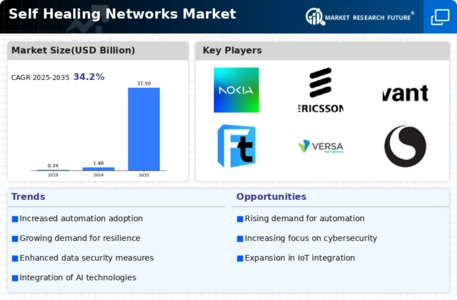Market Trends
Introduction
Into the year 2025, the Self-Healing Neural Networks market is expected to be significantly influenced by a number of macroeconomic factors such as rapid technological advancements, changes in the regulatory framework, and changing consumer behavior. The increasing complexity of the networked devices and the demand for uninterrupted connection have made it essential for the network operators to adopt self-healing capabilities in order to improve the operational efficiency and reliability of the network. Also, the growing regulatory pressure to improve the data security and the privacy of the users is putting further pressure on the companies to invest in self-healing capabilities that can automatically and proactively address the network issues. The changing customer expectations in terms of service availability and real-time response are also driving the network operators to focus on network resilience and adaptability. These factors are expected to create new opportunities for the players operating in the market.
Top Trends
-
AI-Driven Automation
The integration of AI into self-healing networks is revolutionizing the efficiency of operations. IBM is deploying artificial intelligence to anticipate and resolve problems in the network before they impact users. A recent study shows that automation and AI can reduce downtime by as much as 30 percent. This is expected to lead to a major increase in customer satisfaction. -
Enhanced Security Protocols
As the cyber threats evolve, self-healing networks are introducing new security measures. For example, Cisco has introduced self-healing, which automatically detects and eliminates security breaches. In companies that have implemented these protocols, the number of security breaches has fallen by 40 percent. In the future, these networks may also be connected to the Internet of Threats in real time, thus increasing their resilience. -
Decentralized Network Management
In the sphere of self-healing networks, decentralization is becoming a growing tendency, enabling a more agile reaction to problems. Companies such as Ericsson are experimenting with decentralized architectures, where decision-making is devolved to the lowest possible level. This can result in a 25 per cent reduction in reaction times. The tendency may be towards a more fully devolved network management. -
Real-Time Analytics
Proactive management of self-healing networks requires real-time monitoring. The platforms used by companies provide immediate visibility into the performance of their networks. Ivanti reports a 50% reduction in troubleshooting time. The trend will continue with the development of increasingly accurate predictive analytics, which will enable even faster problem resolution. -
Integration of IoT Devices
IoT devices are growing rapidly, which means that self-healing networks are required to manage large amounts of data. For this purpose, Fortra has developed a system that automatically adjusts the network to the IoT traffic pattern. It has been proven that IoT-integrated networks can support up to 60% more devices without performance degradation, thus enabling smarter cities and industries. -
Cloud-Native Architectures
Cloud-native architectures are becoming essential for self-healing networks that can scale and be flexible. The VMware NSX network virtualization platform enables a smooth integration of cloud services with self-healing capabilities. This can reduce the cost of network management by as much as 20 percent. Future developments may focus on hybrid cloud solutions that can increase resilience. -
User-Centric Design
The design of self-healing networks has increasingly adopted a “user-centric” approach to improve the quality of the users’ experience. Companies such as CommScope focus on developing intuitive and easy-to-use interfaces for monitoring and managing the health of the network. Surveys have shown that such designs can increase user engagement by as much as 35%. This trend may lead to more individualized solutions for managing networks. -
Collaboration with Telecom Providers
With the advent of self-healing networks, the number of collaborations between self-healing network operators and telecommunications operators has increased, enhancing service quality. For example, VersaNet Inc. has established a partnership with many major telecommunications operators, enabling them to implement self-healing capabilities in their own networks. This has increased the availability of the telecommunications operators’ networks by 15 percent. Future collaborations may include expanding the scope of services and the global reach of the network. -
Sustainability Initiatives
Self-healing networks are becoming a priority in the development of a society. In industry, energy-saving techniques are being applied to reduce the carbon footprint. It has been estimated that networks based on green technology can save up to 30 per cent of energy. In the future, the emphasis on eco-friendly practices in the design and operation of networks will probably increase. -
Edge Computing Integration
Self-healing networks will be enhanced by the integration of edge computing. It is the processing of data closer to the source which makes it possible to reduce latency. According to studies, the speed of response can be reduced by up to 50 per cent. And this is going to continue with more and more applications relying on real-time processing at the edge.
Conclusion: Navigating the Self Healing Networks Landscape
The market for self-healing networks will be characterized by a highly competitive environment and significant fragmentation as we approach 2025, with a combination of both established and new players competing for market share. Regional trends indicate a growing emphasis on AI-driven solutions and automation capabilities, which are becoming essential for vendors to differentiate themselves. These capabilities will enable the large players to make use of their existing resources, while new companies will focus on developing flexible, smart, and sustainable solutions. Adapting to evolving customer requirements will be critical to gaining a foothold in the market. To maintain a competitive advantage, vendors must strategically align their offerings to meet not only current demands but also anticipate future trends.









Leave a Comment